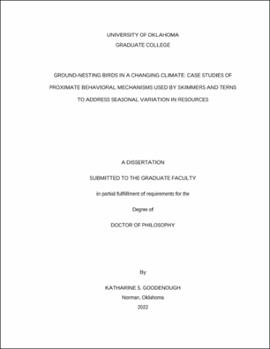| dc.contributor.advisor | Bridge, Eli S. | |
| dc.contributor.author | Goodenough, Katharine S. | |
| dc.date.accessioned | 2022-12-06T21:51:03Z | |
| dc.date.available | 2022-12-06T21:51:03Z | |
| dc.date.issued | 2022-12-16 | |
| dc.identifier.uri | https://hdl.handle.net/11244/336881 | |
| dc.description.abstract | Understanding how species will adapt to anthropogenic climate change is one of the greatest challenges for ecologists and evolutionary biologists. For organisms with low dispersal abilities, rapid adaptation will often be critical for survival. Some species, primarily microorganisms and invertebrates with short generation times, might be able to adapt to changing environmental conditions or evolve in response to climate change. For species with longer generation times, the unusual rate and extent of anthropogenic alterations of the environment may exceed the capacity of mechanisms that populations have evolved to deal with environmental change. It has been posited that behavioral plasticity can reduce exposure to selective pressures and shield population from climate extremes. For this dissertation, I focus upon behavioral mechanisms that are used by individuals and populations to mitigate selective influences upon reproduction. Specifically, the chapters in this dissertation focus on dietary plasticity, alteration in parental reproductive strategies, and seasonal alteration in migration strategies. Combined, the three chapters provide support that phenotypic plasticity in behavior can be an important mechanism used address varying selective pressures in changing environments for longer lived species such as the Black Skimmer and Gull-billed Tern. For dietary generalists, having a degree of opportunism is valuable in changing climates where food resources are vulnerable to changing climactic conditions. Having the ability to alter parental investment, in the form of nest attendance and offspring provisioning can influence offspring survival by accelerating the advancement of offspring to the next developmental stage. And by adjusting migration strategies, individuals can control investment in time and energy allocation which thereby influences both reproduction and individual survival. | en_US |
| dc.language | en_US | en_US |
| dc.rights | Attribution-NonCommercial-NoDerivatives 4.0 International | * |
| dc.rights.uri | https://creativecommons.org/licenses/by-nc-nd/4.0/ | * |
| dc.subject | Avian Ecology | en_US |
| dc.subject | Life History | en_US |
| dc.subject | Climate Change | en_US |
| dc.title | Ground-nesting birds in a changing climate: case studies of proximate behavioral mechanisms used by skimmers and terns to address seasonal variation in resources | en_US |
| dc.contributor.committeeMember | Kelly, Jeffrey | |
| dc.contributor.committeeMember | Weider, Lawrence | |
| dc.contributor.committeeMember | Haugaasen, Torbjorn | |
| dc.contributor.committeeMember | Loraamm, Rebecca | |
| dc.date.manuscript | 2022-11-28 | |
| dc.thesis.degree | Ph.D. | en_US |
| ou.group | Dodge Family College of Arts and Sciences::Department of Biology | en_US |
| shareok.orcid | 0000-0002-6372-8627 | en_US |
| shareok.nativefileaccess | restricted | en_US |

